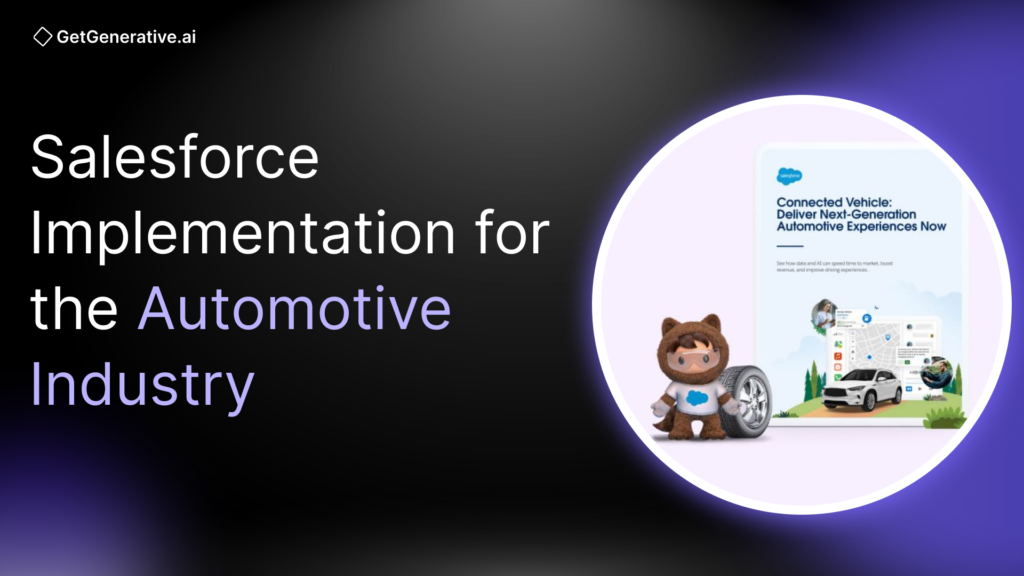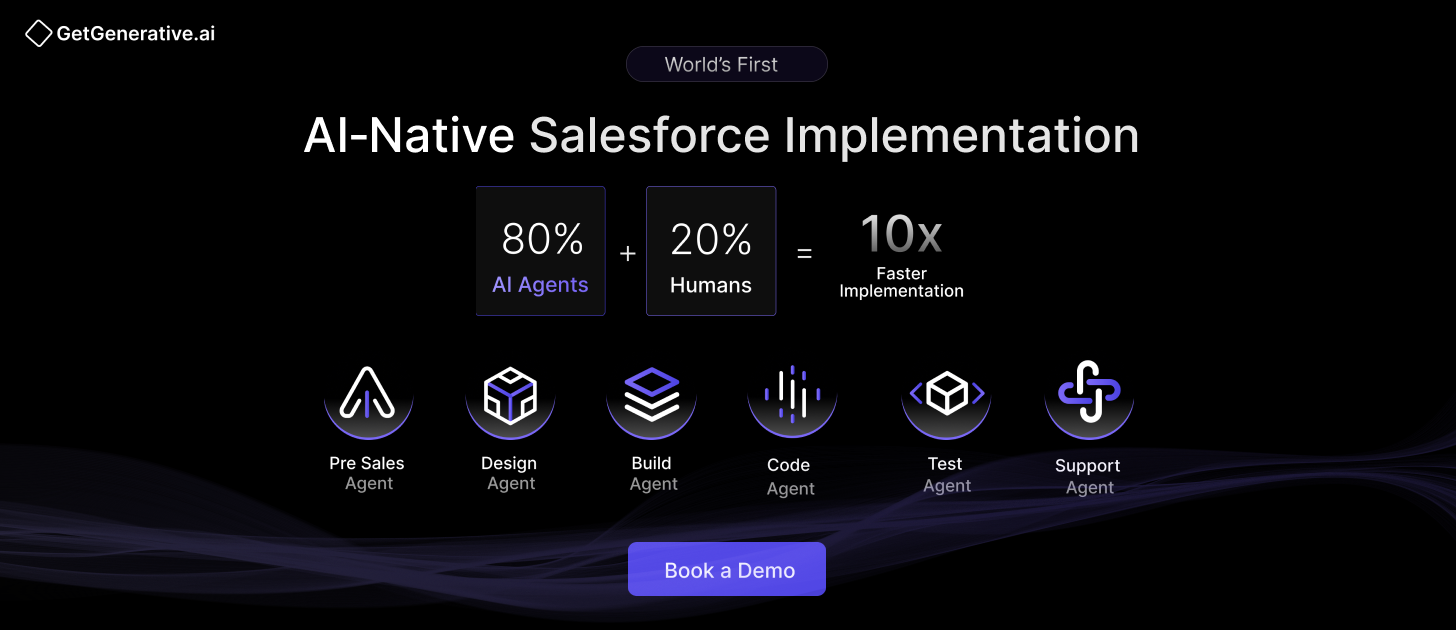Salesforce Implementation for the Automotive Industry
Today’s car buyers and service customers demand personalized, seamless, omnichannel experiences across every touchpoint.
To meet these demands, original equipment manufacturers (OEMs), dealerships, captive finance arms, and auto service networks are embracing cloud-based platforms like Salesforce. These platforms unify data, enable intelligent engagement, and drive operational agility.
According to recent data, the global auto dealership CRM market is expected to grow from $6.13 billion in 2024 to $9.58 billion by 2029, reflecting the increasing pressure to modernize operations and personalize customer experiences.
Let’s explore what’s driving this transformation.
Why Salesforce for the Automotive Industry?
The automotive landscape is defined by complexity—OEMs, dealer networks, third-party service providers, finance companies, and insurance partners all need to collaborate to serve a single customer. Salesforce’s Automotive Cloud was designed to address these challenges by:
- Unifying driver and vehicle data
- Connecting siloed systems (DMS, ERP, telematics)
- Enabling real-time marketing and service engagement
- Powering personalized omnichannel journeys
Salesforce Automotive Cloud: Key Capabilities
Salesforce Automotive Cloud builds upon its core CRM engine to offer auto-specific features. Below are the most impactful capabilities tailored to automotive players:
1. Driver 360 and Vehicle 360 Consoles
These views provide a comprehensive, unified profile of each customer and vehicle.
- Driver 360: Tracks all interactions—sales, service, marketing, call logs, and support cases—across channels. It helps teams identify high-value customers, predict needs, and drive proactive engagement.
- Vehicle 360: Stores warranty details, build information, service history, and recall data for each vehicle. Enables seamless recall tracking, service support, and upsell targeting.
- Household View: Links multiple drivers and vehicles in a family. Useful for marketing cross-sells (e.g., second vehicle offers or loyalty service campaigns).
2. Lead Management and Digital Retailing
- Smart lead routing ensures incoming leads from digital campaigns or portals are scored and automatically assigned to appropriate dealers or reps.
- Quote-to-order processes powered by Revenue Cloud handle vehicle configuration, pricing, financing, and delivery workflows.
- Dashboards track conversion rates, inventory movement, and performance by dealership, region, or salesperson.
3. After-Sales Service and Field Operations
Salesforce Service Cloud centralizes all post-sale engagement:
- Warranty claims, recall notices, and maintenance appointments are auto-logged and triggered by mileage or diagnostic data.
- Field service mobile apps enable on-site repairs and technician routing.
- Smart workflows ensure timely service reminders, driving repeat business and customer loyalty.
4. Marketing Automation and Personalization
Using Salesforce Marketing Cloud:
- Auto marketers can segment by vehicle type, service history, lease cycle, and location.
- Campaigns are automated for upsells, trade-ins, lease ends, and service reminders.
- AI-driven personalization ensures that messages are relevant to customer behavior and preferences.
5. Analytics and Einstein AI
Salesforce’s native AI—Einstein—brings intelligence to every workflow:
- Predictive Lead Scoring: Prioritize leads based on behavior and past engagement.
- Churn Prediction: Identify customers likely to leave or lapse in service and target them with retention offers.
- Dealer Network Analysis: OEMs use Einstein to monitor dealer sales, identify high performers, and optimize incentive programs.
Also Read – Salesforce CRM Implementation With AI – The Ultimate Guide
Salesforce Integration in Automotive Environments
No CRM transformation is complete without deep integration across the auto tech stack. Salesforce excels in this area thanks to its open API architecture and tools like MuleSoft.
Common Integrations:
System | Integration Benefit |
DMS (Dealer Mgmt. System) | Syncs vehicle orders, parts inventory, service records |
Telematics (IoT/Connected Car) | Real-time maintenance alerts, personalized marketing triggers |
Finance & Insurance (F&I) | Cross-sell loan options, track F&I performance per dealer |
CMS & Digital Retail | Connects online vehicle configuration tools to CRM for lead capture |
Partner Portals | Tracks dealer incentives, sales performance, and compliance |
Implementation Strategy: Best Practices for Success
Based on extensive case research, here are 7 key best practices for Salesforce implementation in the automotive industry:
1. Start with a Clear Business Case
Define KPIs early: lead conversion rate, time-to-quote, service retention, etc. This ensures alignment with executive sponsors and budget approvals.
2. Create a Cross-Functional Steering Team
Involve marketing, sales, IT, finance, and dealership leads. Appoint internal champions and executive sponsors for ownership.
3. Prioritize Data Quality and Governance
Cleanse, normalize, and deduplicate records. Implement strong data validation rules and monitoring dashboards to avoid future issues.
4. Roll Out in Phases
Start with one region or business unit. Use agile sprints and MVPs (minimum viable products). Focus on getting quick wins and validating assumptions.
5. Integrate Strategically
Use MuleSoft or AppExchange partners to integrate DMS, ERP, CMS, and telematics platforms. Avoid over-customization early on.
6. Train and Incentivize End Users
Provide training based on user role (sales, service, marketing). Use gamification and real-time feedback loops to increase CRM usage.
7. Measure, Optimize, Iterate
Use Salesforce dashboards and Tableau to continuously monitor usage, performance, and adoption. Run A/B tests for campaigns and improve workflows based on insights.
Leveraging AI and Analytics for Competitive Advantage
AI-Powered Sales Assistants
Salesforce Einstein enables dealerships and OEMs to deploy intelligent chatbots and voice assistants that:
- Automatically respond to common inquiries
- Pre-qualify leads using real-time data
- Schedule test drives or service appointments
- Route high-intent leads to live agents
Predictive Maintenance & Service Intelligence
By integrating vehicle telematics, Salesforce can predict service needs before a failure occurs. Einstein AI can:
- Trigger service reminders based on mileage
- Auto-generate recall alerts and work orders
- Score customers most likely to respond to outreach
Churn Prediction and Upsell Optimization
Einstein AI identifies at-risk customers (e.g., reduced service frequency, expiring warranties) and recommends targeted retention offers.
- Generate tailored email campaigns to win back customers
- Identify upsell-ready segments (e.g., new accessories, extended warranties)
- Use historical service data to recommend next-best actions
Dealer Network Performance Benchmarking
OEMs managing national or global dealer networks use Tableau to:
- Benchmark performance across KPIs (leads, conversions, NPS, inventory turnover)
- Identify underperforming regions
- Optimize incentive programs and training investments
Also Read – Salesforce Proposal Creation With AI: Streamline & Win Deals
ROI from Salesforce in Automotive
A well-implemented Salesforce CRM brings measurable improvements across marketing, sales, service, and operations. Let’s break down the ROI based on real-world outcomes and research.
Revenue Growth
- Forrester TEI Study found a 354% ROI over three years from Salesforce adoption in manufacturing, closely aligned with auto workflows.
- A global OEM using Salesforce Marketing Cloud saw:
- 160% increase in email CTR
- 62% boost in campaign efficiency
- Reduced ad spend per acquisition by 30%
Operational Efficiency
- Ford integrated 20+ legacy systems using MuleSoft into Salesforce, achieving:
- 95% data accuracy
- 60% faster marketing campaign deployment
- Fewer manual handoffs and errors
- Einstein bots reduced agent workload by automating 20% of customer interactions, cutting service costs by up to 50%
Enhanced Customer Experience
- Salesforce CRM enables timely follow-ups, personalized offers, and consistent service—all of which drive satisfaction.
- Global NPS scores improved significantly post-Salesforce adoption in multiple case studies, including Ford, which reported a “notable uplift” in loyalty and engagement.
Common Challenges and How to Overcome Them
Even the best tools can falter if implementation is not managed strategically. Here are typical pitfalls in automotive CRM rollouts—and how to address them.
Challenge | Mitigation Strategy |
Fragmented Data | Cleanse and normalize data pre-migration. Use Salesforce validation rules and deduplication logic. |
Integration Complexity | Invest in MuleSoft or similar middleware. Start with high-impact systems (e.g. DMS, telematics). |
Resistance to Adoption | Focus on user-centric design. Offer training, internal champions, and communicate “what’s in it for me” clearly. |
Scope Creep | Start with an MVP. Use agile sprints. Defer low-priority customizations. |
Lack of Measurable KPIs | Define success metrics from Day 1 (lead-to-sale %, CSAT, ROI, etc.). Use dashboards to track progress. |
Conclusion
From increasing sales and marketing ROI to building long-term customer loyalty, Salesforce unlocks immense value for automotive manufacturers, finance providers, and dealer networks. It offers more than just CRM—it’s a digital transformation engine, ready for the future of mobility.
At GetGenerative.ai, we’ve reimagined Salesforce implementation—built from the ground up with AI at the core. This isn’t legacy delivery with AI added on. It’s a faster, smarter, AI-native approach powered by our proprietary platform.
👉 Explore our Salesforce AI consulting services




